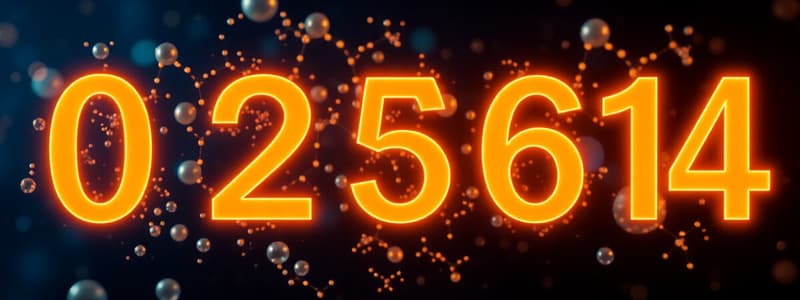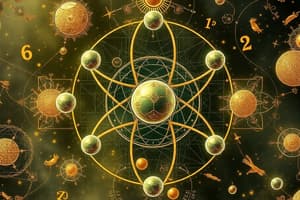Podcast
Questions and Answers
Has the greatest factor among the quantum numbers in determining the atomic radius?
Has the greatest factor among the quantum numbers in determining the atomic radius?
- Magnetic quantum number - ml; spatial orientation of orbital, pertains to charge (- or +)
- Azimuthal quantum number - l; orbital angle and shape and angular momentum (spdf) OSAA
- Principal quantum number - n; size (atomic radius) and overall energy PMS (correct)
- Spin quantum number - ms; Magnetic moment/rotation (cw or ccw)
What is the Pauli's Exclusion Principle?
What is the Pauli's Exclusion Principle?
- An atom cannot have 2 electrons in the same energy level or orbital that have the same set of quantum numbers - qn is unique (correct)
- Electrons in an atom may differ by, at most, one of four quantum numbers
- No two electrons in an atom may have the same principal quantum number
- No more than 2 electrons may have the same set of quantum numbers
What property decreases from left to right, increases from top to bottom?
What property decreases from left to right, increases from top to bottom?
- Electron affinity
- Ionization energy
- Electronegativity (correct)
- Nonmetallic property
- Metallic property
What property reflects how strongly an atom attracts a shared pair of electrons?
What property reflects how strongly an atom attracts a shared pair of electrons?
Which of the following statements best describes elements in the Periodic Table?
Which of the following statements best describes elements in the Periodic Table?
Which group is referred to as the Coinage?
Which group is referred to as the Coinage?
Which of the following is an alkaline earth metal?
Which of the following is an alkaline earth metal?
Which group is referred to as the Alkali Metals?
Which group is referred to as the Alkali Metals?
Which elements are referred to as the Triads of Group 8?
Which elements are referred to as the Triads of Group 8?
Which of the following elements is the most electronegative?
Which of the following elements is the most electronegative?
Arrange the elements according to increasing electronegativity.
Arrange the elements according to increasing electronegativity.
Which halogen has the highest reactivity?
Which halogen has the highest reactivity?
Which of the following elements is the most metallic?
Which of the following elements is the most metallic?
Which of the following is the most acidic?
Which of the following is the most acidic?
In the reaction: U + V + UV when U is added, where will the reaction shift?
In the reaction: U + V + UV when U is added, where will the reaction shift?
Which of the following do not cause a shift in chemical equilibrium?
Which of the following do not cause a shift in chemical equilibrium?
Identify the Lewis acid in the equation: Cl- + BCl3 ⇌ BC14-
Identify the Lewis acid in the equation: Cl- + BCl3 ⇌ BC14-
If the ion product is greater than Ksp, the solution is:
If the ion product is greater than Ksp, the solution is:
All of the following statements about solubility are NOT TRUE, EXCEPT?
All of the following statements about solubility are NOT TRUE, EXCEPT?
States that the entropy of a pure, crystalline solid at absolute zero temperature is zero.
States that the entropy of a pure, crystalline solid at absolute zero temperature is zero.
The second law of thermodynamics deals with which state function?
The second law of thermodynamics deals with which state function?
The following are TRUE about acids & bases, EXCEPT:
The following are TRUE about acids & bases, EXCEPT:
Study Notes
Quantum Numbers and Atomic Properties
-
Principal Quantum Number (n): Determines the size of the electron's orbital and its energy level. Higher n values correspond to larger orbitals and higher energy levels.
-
Azimuthal Quantum Number (l): Describes the shape of the electron's orbital and its angular momentum. Values range from 0 to (n-1).
- l = 0, 1, 2, and 3 correspond to s, p, d, and f orbitals, respectively.
-
Magnetic Quantum Number (ml): Specifies the orientation of the orbital in space, and determines the number of orbitals within a subshell. Values range from -l to +l, including 0.
-
Spin Quantum Number (ms): Represents the intrinsic angular momentum of an electron, often referred to as "spin". Values are either +1/2 or -1/2, representing the direction of spin.
Pauli Exclusion Principle
- No two electrons in an atom can have the same set of four quantum numbers.
- This means each electron in an atom has a unique set of quantum numbers.
Periodic Trends
-
Ionization Energy increases from left to right across a period and decreases from top to bottom within a group. It's the energy required to remove an electron from a gaseous atom.
-
Electronegativity increases from left to right across a period and decreases from top to bottom within a group. It measures an atom's ability to attract electrons in a bond.
-
Atomic Radius decreases from left to right across a period and increases from top to bottom within a group. It's the distance between the nucleus and the outermost electron.
-
Electron Affinity generally increases from left to right across a period and decreases from top to bottom within a group. It's the energy change when an electron is added to a neutral, gaseous atom to form a negative ion.
-
Metallic Character increases from top to bottom within a group and decreases from left to right across a period. It's the tendency of an element to lose electrons and form positive ions.
Chemical Reactions and Equilibrium
-
Le Chatelier's Principle: When a change of condition is applied to a system in equilibrium, the system will shift in a direction that relieves the stress.
-
Shifting Equilibrium:
- Adding reactants shifts the equilibrium to the right, favoring product formation.
- Adding products shifts the equilibrium to the left, favoring reactant formation.
-
Catalyst: A substance that speeds up the rate of a reaction without being consumed, but doesn't affect equilibrium position.
Acid-Base Chemistry
-
Arrhenius Theory: Acids produce H+ ions in solution, bases produce OH- ions.
-
Brønsted-Lowry Theory: Acids donate protons (H+), bases accept protons.
-
Lewis Theory: Acids accept electron pairs, bases donate electron pairs.
Solubility and Thermodynamics
-
Solubility: The maximum amount of a substance that can dissolve in a given solvent at a specific temperature.
-
Factors Affecting Solubility:
- Temperature (increased temperature generally increases solubility for solids, decreases for gases)
- Pressure (increased pressure increases gas solubility)
- Polarity (like dissolves like)
-
Solubility Product (Ksp): The equilibrium constant for the dissolution of a sparingly soluble ionic compound.
- If the ion product (Q) is less than Ksp, the solution is unsaturated.
- If Q equals Ksp, the solution is saturated.
- If Q is greater than Ksp, the solution is supersaturated, and precipitation will occur.
-
Thermodynamics: The study of energy transformations in physical and chemical processes.
-
Laws of Thermodynamics:
- First Law: Energy cannot be created or destroyed, only transferred or transformed.
- Second Law: The entropy of an isolated system always increases over time. Entropy is a measure of disorder.
- Third Law: The entropy of a perfect crystalline solid is zero at absolute zero temperature (0 Kelvin).
Studying That Suits You
Use AI to generate personalized quizzes and flashcards to suit your learning preferences.
Related Documents
Description
Test your understanding of quantum numbers and their significance in atomic properties. This quiz covers the Principal, Azimuthal, Magnetic, and Spin Quantum Numbers, as well as the Pauli Exclusion Principle. Challenge yourself with questions that explore the fundamental aspects of atomic structure.




